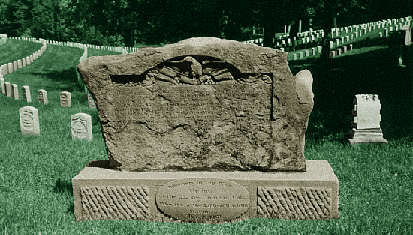32nd INDIANA MONUMENT
CAVE HILL NATIONAL CEMETERY
While still stationed at Munfordville, Kentucky, Adolph Bloettner (August Blodner), a private of Company F, and a survivor of the action at Rowlett's Station, acquired a porous block of local outcrop limestone and sculptured a beautiful monument that was placed at Fort Willich in 1861 to honor those comrades killed in action while defending the bridge. He must have possessed considerable talent in his craft to produce such a heartfelt personal monument to his lost comrades.
Carved in relief near the top, he placed an eagle with wings spread full, clutching a brace of cannon. Two stacks of cannonballs were paired below the artillery with unfurled American flags flanking each side. An olive sprig and an oak branch bordered the recess at each end. Just below this frieze the stone was worked to form the tablet on which, in German, he engraved an account of the battle and the names of the dead with their birth dates.
The German inscription is translated as: "Here rest the first martyrs of the Thirty-second, the first German regiment of Indiana. They were fighting nobly in defense of the free Constitution of the United States of America. They fell on the 17th day of December, 1861, in the battle at Rowlett's Station, in which one regiment of Texas Rangers, two regiments of infantry, and six pieces of rebel artillery, in all over three thousand men, were defeated by five hundred German soldiers." [46]

Memorial to the 1st German, 32nd Indiana Infantry killed at Rowlett's Station, Kentucky in December 1861.
Moved to Cave Hill National Cemetery at Louisville, Kentucky in 1867. Mounted upright on the base stone, the layered limestone was exposed to the damaging effects
of exfoliation, evident in this 1997 photograph.
Once completed, the 32nd laid the monument flat upon the common grave of those men who died while the regiment occupied Ft. Willich. Other units were stationed at Ft. Willich during the course of the war, and a few more men were buried at the site. Some time after Buell's army marched forward to its destiny, the state of Kentucky enclosed the small cemetery within a wrought iron fence. In the early spring of 1867, efforts began to recover all Union dead for reburial in National Cemeteries.
The state of Indiana debated purchasing the site of Ft. Willich for perpetual protection, but those plans never materialized. During the summer of 1867 the monument, along with fourteen sets of remains belonging to the 32nd, was removed from the Munfordville site to set astride the border of Sections B and C in the new National Cemetery within the confines of Cave Hill Cemetery at Louisville, Kentucky. [47] The stone now rests upright on a memorial base with an inscribed commemoration in English that states:
"In memory of the First Victims of the 32. Reg. Indiana Vol. Who fell at the Battle of Rowlettd [sic] Station Dec. 17, 1861."
Two of the names listed on the tombstone, those of Pvt. Theodore Schmidt and Lt. Max Sachs, were not among the remains removed from the fort. Their bodies had been transported to Cincinnati, Ohio, just after the battle and interred in that city on Dec. 20, 1861 and Dec. 22, 1861, respectively. [48] Those at rest under Kentucky soil at Cave Hill at least have home in sight and, just perhaps, they all somehow have the knowledge that the Union, for which they offered the ultimate sacrifice, is still intact.
In the years to come, this beautiful memorial to heroes nearly forgotten, created through the devotion of a comrade, will cease to remind us of the ultimate sacrifice offered by the ancestors of family, friends and neighbors...even though we will always continue to receive the rewards of those offerings. As General Thomas J. Wood, a life-long resident of Munfordville, so eloquently stated in 1867, "Those brave men deserve to have a place in the history of the war and in the hearts of loyal men." We should feel honored and duty-bound to restore and maintain their memory. [49]